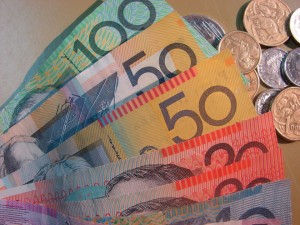 Australian dollar traded slightly higher against its US counterpart during late US session on Friday, after an official report showed employment in the United States increased at a lesser than expected pace in January, while unemployment rate diminished.
Australian dollar traded slightly higher against its US counterpart during late US session on Friday, after an official report showed employment in the United States increased at a lesser than expected pace in January, while unemployment rate diminished.
Having touched daily highs at 0.8999 at 13:57 GMT, also the highest point since January 14th, AUD/USD closed at 0.8959 on Friday, gaining 0.13% for the day. The pair registered a weekly advance of 2.37%. Support was likely to be received at February 5th low, 0.8874, while resistance was to be encountered at January 14th high, 0.9054.
A report made it clear that labor market in the United States showed a weak improvement for a second consecutive month in January, which may fuel concerns over the pace of economic recovery in the country. What is more, such concerns may urge the Federal Reserve Bank to reconsider its current policy of scaling back stimulus at each meeting. US employers added 113 000 new jobs in January, which appeared to be a faster pace compared to December, when non-farm payrolls increased by 75 000. However, Januarys figure remained significantly below the average for 2013 and also below experts expectations of a job growth by 180 000.
Results in a separate survey showed that the rate of unemployment in the United States decreased to 6.6% in January from 6.7% in the preceding month. The number of people hired and also the number of those participating in the work force slightly increased.
Meanwhile, in its quarterly monetary policy statement released on Friday, the Reserve Bank of Australia’s (RBA) revised up its economic growth and inflation rate forecasts for Australia due to weaker exchange rate of the national currency, while also reiterating its neutral stance regarding policy.
Annualized core consumer price index is expected to reach 3.0% in late June, or 0.5% higher in comparison with the previous forecast, announced three months ago. The central bank projects a rate of inflation in the range of 2.25% – 3.25% by December this year, or a revision up by 0.25% compared to the prior forecast.
The RBA also said that factors behind price growth in the final quarter of 2013 were uncertain.
At its meeting on policy on Tuesday the central bank maintained borrowing costs at the current all-time low level of 2.50%, which came in consonance with the majority of analysts’ forecasts. In a statement RBA Governor Glenn Stevens said “the most prudent course is likely to be a period of stability in interest rates.” He also underscored that a lower exchange rate of the Australian dollar may favor a balanced economic growth in the country.
“Monetary policy is appropriately configured to foster sustainable growth in demand and inflation outcomes consistent with the target”, Stevens said.
The yield on Australian benchmark 10-year bonds rose five basis points, or 0.05 percentage point, to reach 4.13% on Friday. Earlier the yield climbed to 4.16%, which has been the highest level since January 23rd.
On Thursday the Australian Bureau of Statistics reported that nation’s trade balance unexpectedly produced a wider surplus at the amount of 0.468 billion AUD in December, following a revised surplus figure of 0.083 billion AUD in November. Preliminary estimates have been confounded, as they pointed to a deficit of 0.225 billion AUD in December.
Australian exports to China rose to 94.5 billion AUD in 2013, which appears to be the largest figure on record.
During the week ahead investors attention will be focused on the closely watched report on retail sales in the United States and the preliminary reading of the index of consumer confidence by Thomson Reuters and University of Michigan.
AUD/USD cross may be influenced by a number of reports, scheduled to be published during next week as follows:
On Monday (February 10th) no relevant reports or events are expected from both Australia and the United States.
On Tuesday (February 11th) Australia is to release data on home loans in December and the index gauging house prices in the last quarter of 2013. Additionally, the National Australia Bank (NAB) is expected to announce the results in its survey on business confidence and business conditions in the country for January.
On Wednesday (February 12th) Westpac Banking Corp. in cooperation with the Melbourne Institute will release the results in their survey on consumer confidence in Australia for February.
On Thursday (February 13th) the Melbourne Institute is to announce the results in its survey regarding consumers inflationary expectations in February. This report will be followed by data on employment change and rate of unemployment in Australia for January.
The United States will release its weekly report on initial jobless claims during the week ended on February 8th, followed by the keenly anticipated report on retail sales for January by the US Census Bureau. Retail sales, as an indicator, provide clues on the tendency in consumer spending, which accounts for almost two thirds of nations Gross Domestic Product.
On Friday (February 14th) the United States will present data on the index of import prices and the index of industrial production in January.
At 14:55 GMT the University of Michigan in cooperation with Thomson Reuters will announce the preliminary value of their index of consumer confidence in February.





